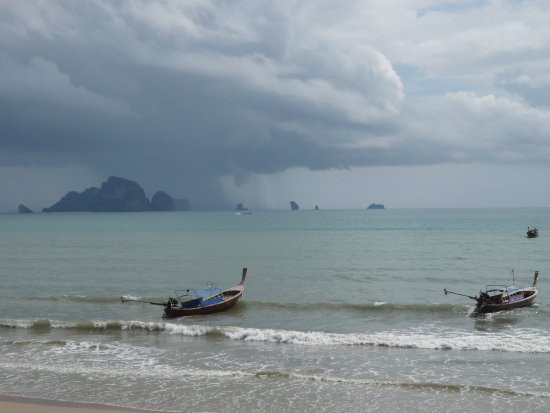The Best Time to Visit Thailand: A Comprehensive Guide
Thailand is a great place to visit. But what is the best time of year to visit Thailand? We have put together a guide, so you know when the best time is to visit Thailand.
Thailand, with its vibrant culture, stunning beaches, and tantalizing cuisine, is a dream destination for many travellers. However, choosing the best time to visit this Southeast Asian gem can be crucial in ensuring an unforgettable experience.
In this comprehensive guide, we will explore the different seasons in Thailand, the weather patterns, and the events and festivals that make each period unique. Whether you’re seeking pleasant temperatures, budget-friendly options, or exciting celebrations, we’ve got you covered.
Understanding Thailand’s Seasons

Thailand experiences three main seasons: high season, shoulder season, and low season. Each season offers distinct advantages and considerations for travellers.
Read:Is My Passport Valid
Thailand High Season: November to March
The high season in Thailand is undoubtedly the most popular time to visit, attracting a large number of tourists from around the world. Running from November to March, this period is characterized by pleasant temperatures, low humidity, and minimal rainfall. With average temperatures hovering around 26-30 degrees Celsius (78-86 degrees Fahrenheit), it’s no wonder that visitors flock to the country during this time.
One of the main advantages of visiting during the high season is the opportunity to explore the stunning beaches on the west coast, such as Phuket and Khao Lak. These destinations enjoy clear skies, calm seas, and lower chances of rain, allowing travellers to bask in the sun and indulge in water activities. Additionally, the northern cities of Chiang Mai and Chiang Rai offer comfortable temperatures, making it an ideal time to explore the cultural and natural wonders of the region.
However, it’s important to note that the high season also coincides with Christmas and the Western New Year holidays, resulting in larger crowds and higher prices. If you prefer to avoid the peak tourist season, consider planning your trip for early November or late March, when the crowds are thinner, but the weather remains favourable.
Thailand Shoulder Season: April to June and September to October
The shoulder seasons in Thailand, spanning from April to June and September to October, offer a mix of advantages and considerations for travellers. During these periods, the weather can be more variable, with higher temperatures, occasional rain showers, and increased humidity. However, the shoulder season also presents opportunities for budget-conscious travellers and those seeking to explore less crowded destinations.
In April to June, Thailand experiences hot and dry weather, particularly in Bangkok, where temperatures can reach 30 degrees Celsius (86 degrees Fahrenheit). Coastal areas, on the other hand, benefit from sea breezes, providing a natural cooling effect. If you don’t mind the heat, this can be an excellent time to visit the coastal regions and enjoy quieter beaches.

September and October mark the end of the rainy season, making it an ideal time to visit the Gulf coast islands, such as Koh Samui and Koh Phangan. These destinations offer a respite from the rain, allowing travellers to enjoy the beauty of the islands without the crowds. However, it’s important to keep in mind that the weather can still be unpredictable during the shoulder season, and occasional rain showers should be expected.
Thailand Low Season: July to August

Thailand’s low season, which occurs from July to August, is characterized by the monsoon season. During this time, the country experiences higher levels of rainfall, particularly in the form of short, intense bursts. While the low season may not be the most popular time to visit, it does offer certain advantages for travellers.
One of the main advantages of visiting during the low season is the opportunity to enjoy significant cost savings. Hotels and accommodations often offer discounted rates, allowing budget travellers to experience Thailand without breaking the bank. Additionally, the reduced tourist influx means that popular attractions and beaches are less crowded, providing a more serene and intimate experience.
However, it’s important to consider the potential downsides of visiting during the low season. Some islands may shut down or have limited services due to the weather conditions, and boat services may be affected. It’s essential to be flexible with travel plans and prepared for the occasional disruption caused by heavy rainfall. Despite these considerations, visiting during the low season can be a rewarding experience for those seeking a more authentic and budget-friendly adventure.
Read:Good Reasons To Visit Lyon
Best Months to Visit Thailand
To further narrow down the best time to visit Thailand, let’s delve into each month and explore the unique events, festivals, and weather conditions that make them stand out.
January in Thailand: Cool and Festive
January marks the beginning of the cool and dry season, making it an excellent time to visit Thailand. With temperatures ranging from 24 to 30 degrees Celsius (75 to 86 degrees Fahrenheit), the weather is pleasant and ideal for outdoor activities.
One of the highlights of January is the Chinese New Year celebrations, which take place across the country. Bangkok’s Chinatown transforms into a vibrant hub of dragon dances, street parades, and firecrackers, creating a lively atmosphere. This cultural extravaganza offers a unique glimpse into Thai Chinese traditions and is a must-see for visitors during this time.
Read:Things To Do In Alicante With Kids
February in Thailand: Sun and Fun
February is still part of the high season in Thailand, but with fewer crowds compared to December and January. The weather remains warm and enjoyable, perfect for exploring the country’s natural beauty and cultural attractions.
One notable event in February is the Flower Festival in Chiang Mai. This three-day extravaganza showcases elaborate floats adorned with vibrant flowers, parades, and cultural performances. It’s a visual feast for the senses and a celebration of Thailand’s rich floral heritage.
March in Thailand: Hot and Festive
As the hot and dry season approaches, March offers pleasant temperatures and an opportunity to enjoy Thailand’s attractions without the peak-season crowds. The beaches start to empty out, making it an ideal time for sun-seekers to soak up the rays.
During March, Thailand’s semester break takes place, with students embarking on sightseeing trips. This can result in increased footfall at popular tourist sites, so planning ahead and booking in advance is advisable. Additionally, March is known for the Mango Season and Kite-Flying Festivals, providing a unique cultural experience for visitors.
Read:Barcelona vs Valencia: Which City Is Best
April in Thailand: Songkran and Hot Weather
April in Thailand brings hot and dry weather, making it an ideal time for outdoor adventures. The temperatures can rise to around 34 degrees Celsius (93 degrees Fahrenheit), so staying hydrated and seeking shade is essential.
One of the most significant events in April is Songkran, the Thai New Year, also known as the Water Festival. Celebrated across the country, Songkran involves water fights, parades, and religious ceremonies. It’s a lively and joyous celebration that marks the arrival of the hot season and offers a unique cultural experience for visitors.
May in Thailand: Rain and Festivals
May marks the beginning of the rainy season in Thailand, with occasional rain showers and increased humidity. However, this period also presents opportunities to witness unique festivals and experience the country’s cultural heritage.
Rocket Festival and Royal Ploughing Ceremony are two notable events in May. The Rocket Festival, held in northeastern Thailand, involves the launching of homemade rockets into the sky, symbolizing the hope for abundant rainfall and a bountiful harvest. The Royal Ploughing Ceremony, on the other hand, is a traditional event held in Bangkok, where royal oxen plow a ceremonial field, predicting the year’s agricultural prospects.
June in Thailand: Rain and Festivities
June continues the rainy season in Thailand, with showers that are often brief but can be intense. Despite the occasional rain, this period offers unique festivals and activities for visitors to enjoy.
One of the highlights of June is the Phi Ta Khon festival in the northeastern province of Loei. Also known as the Ghost Festival, it features colourful masks, traditional costumes, and lively parades. Another event worth experiencing is the Hua Hin Jazz Festival, where renowned jazz musicians perform against the backdrop of the stunning beach.
July in Thailand: Rainy Season and Buddhist Traditions

July marks the continuation of the rainy season in Thailand. While the weather may not be ideal for outdoor activities, this period offers opportunities to witness significant Buddhist traditions and celebrations.
Asahna Bucha and Khao Phansaa are two important events in July. Asahna Bucha commemorates the Buddha’s first sermon and is observed with candlelit processions and temple visits. Khao Phansaa, also known as Buddhist Lent, is a period of reflection and meditation for monks, and it’s marked by ceremonies and merit-making activities.
Read:Magic Natura Benidorm Review
August in Thailand: Overcast Skies and Buddhist Celebrations
August falls in the middle of the rainy season, with overcast skies and daily showers. Despite the weather, this period offers opportunities to witness significant Buddhist celebrations and immerse yourself in Thai culture.
One notable event in August is the celebration of HM the Queen’s Birthday. This is a time when Thai people come together to honour and pay tribute to their beloved queen. The celebrations often include parades, cultural performances, and ceremonies held across the country.
September in Thailand: Rain Continues
September continues the rainy season in Thailand, with occasional showers and continued humidity. However, this period also offers unique festivals and cultural experiences for visitors.
One of the most vibrant events in September is the Vegetarian Festival, held in Phuket. This festival showcases a wide variety of vegetarian dishes and offers a glimpse into the rich culinary traditions of Thailand. Additionally, the festival features processions, ceremonies, and unique rituals, such as firewalking and body piercing.
October in Thailand: Rain Subsides and Festivals
October marks the transition from the rainy season to cooler temperatures and reduced rainfall in Thailand. This period offers a pleasant climate and a chance to witness some of the country’s most exciting festivals.
One notable event in October is the Vegetarian Festival, which continues from September. Additionally, the month features the Bangkok Biennale, an international contemporary art event that showcases the works of both local and international artists. This festival provides a unique opportunity to explore the vibrant art scene of Thailand.
November in Thailand: Cool and Lush
November marks the beginning of the cool and dry season in Thailand, offering comfortable temperatures and lush landscapes. This period is ideal for outdoor activities and exploring the country’s natural beauty.
One of the most significant events in November is the Loi Krathong festival, also known as the Lantern Festival. This enchanting festival involves floating lanterns on rivers and releasing them into the night sky, symbolizing the release of negativity and making wishes for the future. The festival is celebrated across the country, with Chiang Mai being a popular destination for witnessing this magical spectacle.
December in Thailand: Peak Tourist Season and Festive Spirit
December marks the peak tourist season in Thailand, as travellers flock to the country to escape the colder weather in their home countries. The weather is cool and dry, making it an ideal time to explore the beaches, cities, and cultural sites.
One of the highlights of December is the Chiang Mai Red Cross & Winter Fair, a vibrant event featuring food stalls, live performances, and traditional games. It’s an opportunity to immerse yourself in the festive spirit and experience the local culture.
Thailand offers a diverse range of experiences throughout the year, making it a captivating destination regardless of the season. Whether you prefer the pleasant temperatures of the high season, the budget-friendly options of the shoulder season, or the unique festivals of the low season, there is a perfect time to visit Thailand for every traveller. By understanding the different seasons, weather patterns, and cultural events, you can plan your trip to Thailand and make the most of your visit.
Remember to check the latest travel advisories and entry requirements before planning your trip, as regulations may vary. Now that you have a comprehensive guide to the best time to visit Thailand, start planning your adventure and get ready to create unforgettable memories in the Land of Smiles.


